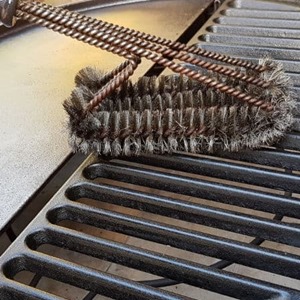If you truly value great cookware and cooking equipment in general, chances are that you have already bought yourself a piece of cast iron. With a reputation to live practically forever, this material requires some tending to, in order to stay that way. Grill and Skill team decided to dedicate this guide to anyone that is planning to get a cast iron grill grate or already has one, being that they have some troubles cleaning it, or they want to restore a long-forgotten cast iron grate.
The Material of the Past and the Future
We are sure that many of you have gotten their cast iron cookware form your parents or even grandparents. The fact of the matter is, if handled properly, cast iron can serve you and you can leave it to your children to enjoy grilling on it.
This material is essentially made by adding carbon to iron but in a much larger ratio. It is molded and every cast iron piece of cookware is made from a single piece, always. Besides just cleaning a cast iron grill or griddle after a cookout, or restoring an old one from the attic, we are going to touch on the topic of seasoning. This is a process that makes cast iron gives off a unique flavor to the food, and that makes it lasts virtually forever. Additionally, this guide can serve to anyone out there owning other cast iron cookware, like pans and skillets. The process is the same almost always.
Cleaning a Cast Iron Grill Grate
 There is a general rule that a lot of grill masters simply forgets: the best way to maintain your cast iron grill grate in a healthy condition is to clean it right after you are done grilling. Now, we are not saying that you need to do this excessively, but every third time you are done with making delicious burgers and stakes, it would be good to give the old grate a cleaning.
There is a general rule that a lot of grill masters simply forgets: the best way to maintain your cast iron grill grate in a healthy condition is to clean it right after you are done grilling. Now, we are not saying that you need to do this excessively, but every third time you are done with making delicious burgers and stakes, it would be good to give the old grate a cleaning.
So, when you finish with the food, the very first thing you need to do is close the grill lid (if there is one) and turn the temperature as high as you can. For electric and gas grills this is done simply by turning the valve or a switch on the side. However, if you own a charcoal burning grill, you will have to make a few steps.
Charcoal grills rise and lower the heat by feeding the fire with oxygen, or by choking it. This is achieved by a system of vents on the bottom and top side of the grill, and you should open them in their entirety. This will raise the temperature pretty high, so make sure there are no objects around the grill, for safety reasons. Next, turn off the grill (or choke the fire by completely closing the vents on a charcoal grill) and wait for it to cool off. The reason why you need to “bake” and empty grill grate is simple: On extremely high temperatures bacteria and food leftovers are burnt to a crisp and they fall off of the grate.
After this crucial step is done, and the grate has cooled off, carefully take it out and let it cool down a few moments more. Use a dry cloth to remove any carbonated food that might not have fallen off the grate, and to remove possible excess moisture. If the grate is clean, it is time to season it and store it for later use (more about seasoning later). However, if it is still dirty, it is time to take the next step.
Washing a Cast Iron Grill Grate
If the cast iron grill grate is still filthy, some elbow grease will be needed in the further steps to clean it. You will need some regular household soap and a lot of warm running water. Put the cast iron inside the sink and run warm-to-hot water over it. Remember to let the grate cool off completely before this step, or you might damage the cast iron permanently because temperature shocks can make it crack.
After the grate is completely wet, use the soft side of the sponge and some soap to rub it. Be firm, but gentle, without fast movements. Cast iron is somewhat soft in its nature, and with fast and energetic cleaning maneuvers its surface can be damaged, which later allows water to penetrate and cause rust.
If the stains on the grate stay on, you can use some soft steel wool or dedicated tools for cleaning sensitive surfaces to give it another chance. Rinse with a lot of warm water and dry with a clean cloth. We cannot stress this enough: properly drying a cast iron grill grate is of utmost importance! The whole cleaning process will be for nothing if it remains wet, even to a small degree, however, there’s a way to be sure it is dry. If you want to play safe, put the cleaned grill grate into an oven and turn the temperature to low. This will evaporate all possible leftover water on its surface and prevent damage by rust.
If you leave it wet and store it that way, you will surely have to clean up a way bigger mess than some burger grease is.
Restoring a Rusty Cast Iron Grill Grate
Neglect and improper storage of a cast iron grill grate almost always lead to rust. Now, don’t demoralize yourself, this can happen even to most experienced world-renown grill masters.
Do not be afraid, because there are a few things you can do to restore rusty cast iron to its former glory. This may take a good chunk of your day, but hey, it is worth every minute. Considering stages of rust from least to most rusty, the process goes like this:
- Clean the excess dust and greasy after you take the grate out of storage. You can use a dry or slightly soaked cloth. Let the grate rest for 15 minutes. After this, soak the cast iron in some hot soapy water and use steel wool to remove rust particles. Remember, strong but not quick movements. When the rust marks are gone, rinse with warm water, dry with a cloth and use the oven on low heat to evaporate any micro water drops. All you have to do is season the grate and will be like new.
- If you are dealing with stubborn rust, or just large amounts of it, you will have to go a step further and use vinegar. Dust off the grill grate and make a 1/1 mixture of warm water and white vinegar. Let the cast iron grill grate soak in this vinegar bath for a maximum of 2 hours.
When the soaking is done, rinse with warm water, dry with a clean cloth and put into the oven on low heat to finish the drying process.
This type of cleaning will cover most rust and leftover food stains that can attack a cast iron grill grate. However, if there are times when a grate ends up in storage for a long, long time. In this case, we need the big guns! - When it comes to really horrific grate states, due to rust, dust, and elements in general, the last resorts would be to use alkaline, lye containing oven cleaner. Clean the grill grate as much as you can by doing steps 1 and 2. After you remove some damages, get some oven cleaner, some large garbage bags and a box that can fit the cast iron grill grate inside.
Put the grate in the garbage bag and soak it with alkaline oven cleaner. After it’s soaked, get another bag and make sure that it is sealed with the soaked grate inside. Put everything in the box and store the box in a warm and dry place (out of reach of children and pet animals), for a couple of days. When the time comes, get the grate out of the box and rinse it with warm water. Remember to use safety equipment like latex gloves and some safety glasses. Just in case, put some old clothes on. This process will get through the strongest of stains, rust or other. After the grate is dry, season it and store it in a safe and dry place.
Seasoning the Cast Iron Grill Grate
After every cleaning session, it would be ideal to season the cast iron cookware, no matter the shape and size. Seasoning involves creating a very thin layer of the nonstick water-resistant surface. It is achieved like this:
- Warm up the grill to a high temperature, with the grate on
- Take a cloth and soak it in oil (olive, palm, coconut, etc.) and apply it on the grate in a thin layer, using a pair of tongs. You can also use lard.
- Wait for the oil to harden on the surface of the cast iron grill grate, thus creating a film that will not allow humidity or dust to penetrate its surface.
One Final Thought
There are numerous reasons why cast iron is popular. It enriches the taste of the food you make, and every additional seasoning is only adding to it. It has extremely long durability, and the heat properties are like no other cooking material out there. The only hassle you need to go through is maintaining the cast iron cleaned and seasoned.
And now you know how to do that, so ultimately, nothing can stand between you and those juicy steaks. Enjoy!
